Europe Calendar in 2025 - List of Public Holidays: Celebrations, And Activities
An Overview of Public Holidays Across Europe
Comprising 44 different countries with individual histories, languages, and cultures, Europe is a vivid tapestry. Celebrated for their cultural diversity and rich legacy, European countries span the Atlantic coast of Portugal to the great landscapes of Russia. National public holidays are one of the most obvious ways one can see this variety over the continent. These unique days let people gather to celebrate religious observances, historical events, cultural traditions, and national identities that define every nation.
European public holidays, sometimes referred to as national holidays, have their roots in a confluence of religious, historical, and cultural customs. Though the way these days are observed varies from one nation to another, many holidays including Christmas and Easter reflect Europe's strong Christian legacy. Other holidays such as German Unity Day in Germany or Bastille Day in France honor particular historical events that shaped the identity of every country.
With customs sometimes handed down through the years, holidays are observed across Europe with parades, religious ceremonies, feasts, and celebrations. These holidays are essential for maintaining and spreading cultural values, historical memories, and unity among the European community; they are not only days for rest.
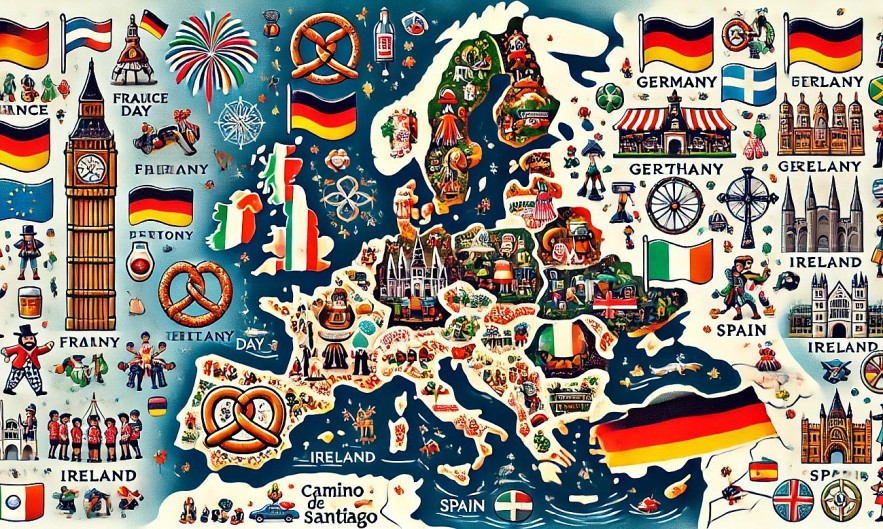 |
| Public Holidays in Europe 2025 |
Below is a month-by-month exploration of Europe’s public holidays, including universally celebrated holidays and those unique to individual countries.
Popular Public Holidays Across Europe
Certain public holidays are celebrated across much of Europe and, in some cases, the world. These include New Year’s Day, Labor Day, Christmas, and Easter. Each of these holidays carries universal themes yet varies in how it’s observed depending on local customs, national history, and cultural beliefs. Below is a look at these widely recognized holidays and how they’re celebrated across Europe.
-
New Year’s Day (January 1)
New Year’s Day is a universal celebration marking the start of the calendar year. Across Europe, New Year's Eve festivities on December 31 are lively, with fireworks, parties, and gatherings, often carrying over into New Year’s Day. In Scotland, for example, Hogmanay celebrations last for several days and include torch-lit processions, dancing, and singing “Auld Lang Syne.” In Eastern Europe, some traditions combine New Year’s celebrations with Orthodox Christmas festivities, making January a month of extended celebration.
-
Labor Day / International Workers’ Day (May 1)
Many European nations observe May Day with parades, demonstrations for workers' rights, and public gatherings. In countries like Germany and France, large rallies and festivals highlight the achievements of the labor movement, while in the UK, some communities hold traditional Maypole dancing and Morris dancing events.
-
Christmas (December 25)
Most European countries celebrate Christmas on December 25, but Orthodox Christian nations like Russia and Serbia celebrate it on January 7. Christmas celebrates the birth of Jesus Christ with religious ceremonies, festive meals, and gift-giving. In Italy, families celebrate the “Feast of the Seven Fishes,” while in Germany, Christmas markets and Advent calendars make the season festive. Christmas crackers and Boxing Day on December 26 are essential to UK Christmas celebrations.
-
Easter (Variable Date in Spring)
Easter is one of Christianity's most important holidays, celebrating Jesus Christ's resurrection in spring. Easter traditions vary widely across Europe due to cultural and religious differences. Catholic-majority countries like Spain have elaborate and solemn Easter processions, while Eastern Orthodox nations have colorful egg-painting, church services, and festive meals. A four-day weekend with local customs is common in countries that celebrate Good Friday and Easter Monday as public holidays.
Unique National Holidays in European Countries
While some holidays are celebrated widely across Europe, each country also has unique holidays specific to its history, culture, and heritage. Here are a few examples:
Bastille Day (France, July 14)
Bastille Day commemorates the French Revolution’s beginning in 1789. Celebrations in France include military parades on the Champs-Élysées, firework displays, concerts, and festivals. It’s a day of national pride, symbolizing liberty, equality, and fraternity.
German Unity Day (Germany, October 3)
German Unity Day celebrates the reunification of East and West Germany in 1990. It is marked by public ceremonies, festivals, concerts, and official addresses. Berlin hosts a major celebration at Brandenburg Gate, attracting visitors from across the country.
St. Patrick’s Day (Ireland, March 17)
Originally a religious observance honoring St. Patrick, Ireland’s patron saint, St. Patrick’s Day has become a global celebration of Irish culture. In Ireland, it’s marked by parades, music, and green attire, while cities worldwide also hold festivities in solidarity.
National Day of Catalonia (Spain, September 11)
Observed in Catalonia, this day commemorates the region’s fight for autonomy. Celebrations include cultural events, political demonstrations, and expressions of Catalonian heritage and pride.
Festa della Repubblica (Italy, June 2)
Italy’s Republic Day marks the 1946 referendum when Italians voted to abolish the monarchy in favor of a republic. Celebrated with military parades and public events, it’s a day of patriotic pride and reflection on Italy’s democratic roots.
Public Holidays in Europe 2025 (January to December) And Celebrations
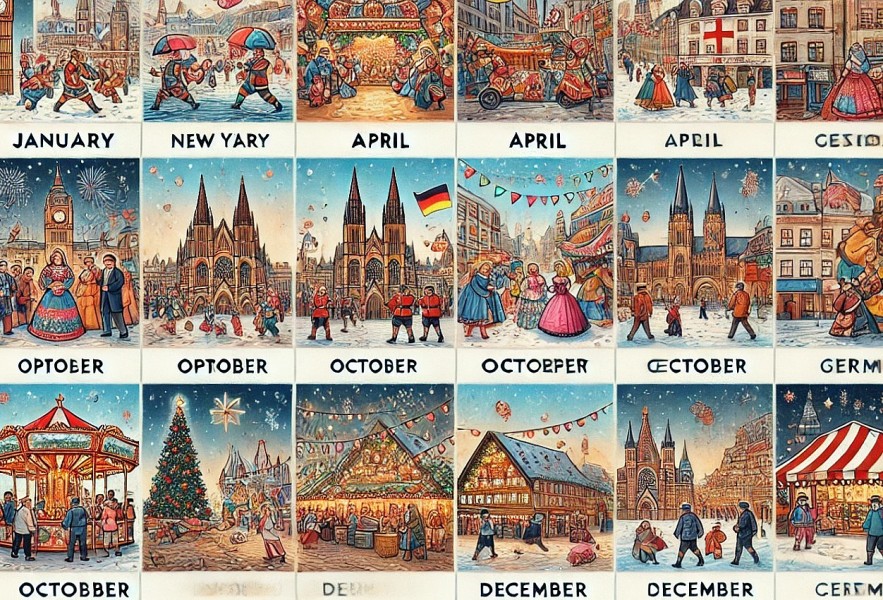 |
| The month-by-month celebration montage |
January
-
New Year’s Day (January 1)
- Timing: Celebrated on January 1 across Europe.
- Origin: Rooted in the ancient Roman celebration of the new year and adopted into the Christian calendar.
- Significance: Marks the beginning of the calendar year, symbolizing new beginnings and resolutions.
- Celebrations:
- Scotland: Hogmanay celebrations involve torch-lit processions, dancing, and singing "Auld Lang Syne" at midnight.
- Spain: Spaniards traditionally eat twelve grapes at midnight, one for each chime, to bring good luck for each month of the year.
- France and Germany: Fireworks, family gatherings, and New Year’s wishes mark the day.
-
Epiphany (January 6)
- Timing: Observed on January 6, especially in Catholic and Orthodox countries.
- Origin: Commemorates the visit of the Three Wise Men to the newborn Jesus, also known as the “Feast of the Three Kings.”
- Significance: A religious holiday marking the end of the Christmas season.
- Celebrations:
- Spain: Known as “Día de los Reyes” or “Three Kings’ Day,” children receive gifts as it’s traditionally considered the real Christmas gift-giving day.
- Italy: Befana, a folklore figure, brings gifts to children on Epiphany. Processions and feasts are held to celebrate.
- Austria and Germany: Church services and family gatherings, with children dressing as the Three Kings to bring blessings to homes.
February
-
St. Valentine’s Day (February 14)
- Timing: Celebrated on February 14 across Europe, though not as a public holiday.
- Origin: St. Valentine’s Day is named after St. Valentine, a Christian martyr, and has become a popular celebration of love and affection.
- Significance: Focuses on romantic love and friendship.
- Celebrations:
- France: Known as the “City of Love,” Paris hosts events, and couples exchange gifts.
- Italy: A popular day for romantic dinners, with Verona, home of Romeo and Juliet, hosting events.
- UK and Ireland: Exchanging cards, flowers, and chocolates is traditional, with themed events in many cities.
 Top 20 Most Romantic Love Movies to Watch on Valentine’s Day Top 20 Most Romantic Love Movies to Watch on Valentine’s Day |
-
Carnival / Mardi Gras (February, varies based on Lent)
- Timing: Takes place before Lent, usually in February or early March.
- Origin: Rooted in the Christian tradition of Lent, it’s a time of revelry before the period of fasting.
- Significance: Represents a final celebration before Lent, with music, costumes, and parades.
- Celebrations:
- Italy: The Venice Carnival is world-renowned for its elaborate masks, costumes, and balls.
- Spain: The Cádiz Carnival is famous for its satirical parades and colorful costumes.
- Portugal: In Lisbon and Madeira, Carnival is celebrated with street parades, samba dancing, and festive events.
March
-
St. Patrick’s Day (March 17)
- Timing: Celebrated on March 17 in Ireland and among Irish communities across Europe.
- Origin: Honors St. Patrick, the patron saint of Ireland, who is credited with spreading Christianity in Ireland.
- Significance: A celebration of Irish heritage and culture.
- Celebrations:
- Ireland: Major parades and cultural events in cities like Dublin, with people wearing green and enjoying traditional Irish music and food.
- UK: Large St. Patrick’s Day celebrations in cities with Irish communities, such as London and Birmingham, often with parades and festivals.
- Spain: Although not a national holiday, many bars and pubs in Spain, especially in Madrid, hold themed events for locals and tourists.
-
Greek Independence Day (March 25)
- Timing: Celebrated annually on March 25 in Greece.
- Origin: Commemorates the beginning of the Greek War of Independence from the Ottoman Empire in 1821.
- Significance: A day of national pride and remembrance for Greece’s struggle for independence.
- Celebrations:
- Greece: Military parades in Athens, traditional dances, and church services.
- Cyprus: Similar celebrations with parades and events in solidarity with Greece.
April
-
Easter (Variable Date)
- Timing: Easter Sunday falls on different dates depending on the year and is celebrated by Catholic, Protestant, and Orthodox Christians, typically in March or April.
- Origin: Celebrates the resurrection of Jesus Christ and is considered Christianity’s most important holiday.
- Significance: Represents renewal, resurrection, and hope.
- Celebrations:
- Spain: Holy Week (Semana Santa) features elaborate processions in cities like Seville and Málaga, with participants carrying large religious floats.
- Italy: Processions, church services, and family gatherings. In Florence, “Scoppio del Carro” (the explosion of the cart) is a traditional Easter event.
- Greece: Orthodox Easter is marked by midnight church services, candle lighting, and festive meals with lamb as the main dish.
-
St. George’s Day (April 23)
- Timing: Observed on April 23, primarily in England and other countries where St. George is the patron saint.
- Origin: St. George’s Day commemorates St. George, a Christian martyr and legendary dragon-slayer.
- Significance: Celebrates the patron saint of England and is a symbol of courage.
- Celebrations:
- England: Parades, flag displays, and historical reenactments; traditional English foods are enjoyed in pubs and public events.
- Catalonia, Spain: Known as “La Diada de Sant Jordi” (St. George’s Day), it’s celebrated by exchanging roses and books, making it similar to Valentine’s Day.
- Bulgaria: Known as “Gergyovden,” it’s a significant day with feasts and agricultural rituals to welcome spring.
May
-
Labor Day / International Workers’ Day (May 1)
- Timing: Celebrated on May 1 across Europe.
- Origin: Originating from the labor movement in the late 19th century, it highlights workers’ rights and solidarity.
- Significance: Recognizes labor achievements and serves as a day of advocacy for workers’ rights.
- Celebrations:
- France and Germany: Parades and demonstrations in support of workers' rights, along with public speeches and cultural events.
- UK: Traditional May Day celebrations include Maypole dancing and Morris dancing, especially in England.
- Italy: Known as “Festa dei Lavoratori,” cities host concerts, and rallies organized by labor unions are common.
-
Victory Day (May 8 or May 9)
- Timing: May 8 in Western Europe; May 9 in Russia and several Eastern European countries.
- Origin: Commemorates the end of World War II in Europe, marking the Allied victory over Nazi Germany in 1945.
- Significance: A day to remember those who served and honor the sacrifices made during the war.
- Celebrations:
- France: Celebrations include laying wreaths at war memorials, including a major ceremony at the Arc de Triomphe in Paris.
- Russia: Victory Day (День Победы) on May 9 is a major holiday featuring a large military parade in Moscow's Red Square and veterans’ gatherings.
- Poland: Memorial services and exhibitions are held to educate about Poland’s role in the war and the significance of victory.
-
Europe Day (May 9)
- Timing: Celebrated on May 9 within EU member states.
- Origin: Marks the 1950 Schuman Declaration, which laid the foundation for what would become the European Union.
- Significance: Symbolizes peace and unity across European countries.
- Celebrations:
- Brussels: The European Union’s institutions hold open houses and exhibitions, while cities across Europe host events promoting European integration.
- France, Germany, and Spain: Public events and cultural activities are organized to celebrate European values and promote unity.
June
-
Republic Day / Festa della Repubblica (Italy, June 2)
- Timing: June 2, celebrated in Italy.
- Origin: Commemorates the 1946 referendum in which Italians voted to replace the monarchy with a republic.
- Significance: Marks Italy’s transition to a republic and celebrates the nation’s democratic values.
- Celebrations:
- Rome: A grand military parade, as well as ceremonies at the Altare della Patria, where the President lays a wreath at the Tomb of the Unknown Soldier.
- Other Italian cities: Smaller parades, cultural events, and public concerts.
-
Midsummer (June 24)
- Timing: June 24, though celebrations vary by country, often occurring around the summer solstice.
- Origin: Midsummer has ancient pagan origins, associated with the summer solstice and the celebration of nature and fertility.
- Significance: Represents the longest day of the year and is a celebration of the warmth and growth of summer.
- Celebrations:
- Sweden: Known as “Midsommar,” celebrations include dancing around a maypole, traditional Swedish food, and wearing floral crowns.
- Finland: Bonfires are lit by lakesides, and families gather for feasts and outdoor activities.
- Baltic countries: In Estonia, Latvia, and Lithuania, Midsummer is a national holiday celebrated with singing, bonfires, and cultural performances.
July
-
Bastille Day (France, July 14)
- Timing: Celebrated on July 14 across France.
- Origin: Marks the storming of the Bastille prison in 1789, a key event in the French Revolution.
- Significance: Symbolizes the spirit of liberty, equality, and fraternity in France.
- Celebrations:
- Paris: A major military parade takes place on the Champs-Élysées, followed by fireworks at the Eiffel Tower and public concerts.
- France-wide: Festivities include local parades, fireworks, dances, and communal gatherings to celebrate national pride.
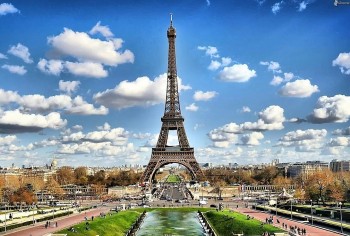 France Calendar in 2025 - Full List of Public Holidays And Observances: Dates and Celebrations France Calendar in 2025 - Full List of Public Holidays And Observances: Dates and Celebrations |
-
St. James’ Day (Spain, July 25)
- Timing: Observed on July 25 in Spain, especially in the Galicia region.
- Origin: Honors Saint James, the patron saint of Spain, who is said to be buried in Santiago de Compostela.
- Significance: Celebrated as a day of religious pilgrimage and national pride.
- Celebrations:
- Santiago de Compostela: Thousands of pilgrims complete the Camino de Santiago, arriving at the Cathedral for a special mass.
- Galicia: Public events, festivals, and performances celebrate Galician culture, with fireworks in Santiago marking the day’s end.
August
-
Assumption Day (August 15)
- Timing: Celebrated on August 15 in many Catholic-majority countries.
- Origin: Commemorates the assumption of the Virgin Mary into heaven, a key belief in Catholic doctrine.
- Significance: A religious holiday honoring the Virgin Mary and an important time for pilgrimage and worship.
- Celebrations:
- Italy: Known as “Ferragosto,” Italians celebrate with family feasts, beach outings, and traditional events in cities like Rome.
- France: Many attend church services, and parades are held in cities and towns. Coastal areas see an influx of visitors as families go on vacation.
- Spain: In several towns, religious processions are held, and people enjoy festivals and fairs.
-
San Marino National Day (San Marino, September 3)
- Timing: Celebrated on August 15 in San Marino.
- Origin: One of the world’s oldest republics, San Marino celebrates its independence and enduring sovereignty.
- Significance: A day of national pride and reflection on the republic’s history.
- Celebrations:
- San Marino: Events include historical reenactments, a military parade, and public speeches, with fireworks marking the end of the day.
September
-
National Day of Catalonia (September 11)
- Timing: Observed on September 11 in Catalonia, Spain.
- Origin: Commemorates the fall of Barcelona during the War of Spanish Succession in 1714, which led to the loss of Catalan autonomy.
- Significance: A day of Catalonian pride and cultural identity, highlighting the region’s distinct history and aspirations.
- Celebrations:
- Barcelona: Public rallies and marches, along with cultural events celebrating Catalan language, music, and traditions.
- Catalonia-wide: People display Catalan flags (the Senyera) on balconies, and local governments organize concerts and exhibitions showcasing Catalonian heritage.
-
San Marino National Day (September 3)
- Timing: Celebrated annually on September 3 in San Marino.
- Origin: Celebrates the founding of the Republic of San Marino, one of the oldest republics in the world, established in AD 301.
- Significance: A day to honor San Marino’s independence and long-standing republic status.
- Celebrations:
- San Marino City: Events include a historic crossbow tournament, parades, and public festivities with fireworks in the evening.
October
-
German Unity Day (October 3)
- Timing: Celebrated on October 3 in Germany.
- Origin: Marks the reunification of East and West Germany in 1990 after decades of division following World War II.
- Significance: A national holiday celebrating German unity and the end of the Cold War division.
- Celebrations:
- Berlin: Major festivities at the Brandenburg Gate, including concerts, cultural exhibitions, and official speeches.
- Germany-wide: Cities host parades, and educational exhibits highlight the country’s journey towards reunification.
-
Halloween (October 31)
- Timing: Celebrated on October 31, particularly in Ireland and the UK, with growing popularity across Europe.
- Origin: Originates from the ancient Celtic festival of Samhain, marking the end of the harvest season and the beginning of winter.
- Significance: Halloween has become a celebration of costumes, supernatural stories, and festive activities.
- Celebrations:
- Ireland and UK: Trick-or-treating, costume parties, and haunted house events are popular.
- France and Germany: While not traditionally celebrated, Halloween has gained popularity, with costume events in larger cities.
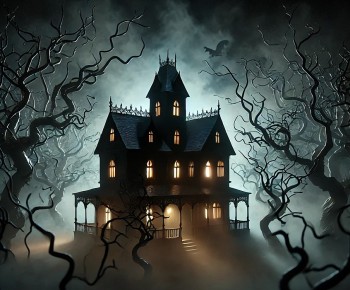 Top 10 Scariest Ghost Stories of All Time You Should Read This Halloween Top 10 Scariest Ghost Stories of All Time You Should Read This Halloween |
November
-
All Saints’ Day (November 1)
- Timing: Celebrated on November 1 across Catholic-majority countries in Europe.
- Origin: A Christian tradition that honors all saints, known and unknown.
- Significance: A solemn day of remembrance for the deceased.
- Celebrations:
- France: Families visit cemeteries to place flowers on loved ones’ graves.
- Spain: Known as “Día de Todos los Santos,” Spaniards hold church services and visit graves, often followed by traditional feasts.
- Italy: Observed with church services, and families often bring flowers to cemeteries.
-
Armistice Day (November 11)
- Timing: Observed on November 11 in countries like France, Belgium, and the UK.
- Origin: Commemorates the armistice that ended World War I in 1918.
- Significance: A day to remember and honor those who served in wars.
- Celebrations:
- France: Ceremonies held at war memorials, with a major event at the Arc de Triomphe in Paris.
- UK: Observed as Remembrance Day, with a two-minute silence and the wearing of poppies in honor of fallen soldiers.
- Belgium: Memorial services and gatherings, particularly in the city of Ypres, an important WWI site.
December
-
St. Nicholas Day (December 6)
- Timing: Celebrated on December 6 in several European countries.
- Origin: Honors St. Nicholas, a 4th-century saint known for his generosity and miracles.
- Significance: The precursor to modern-day Santa Claus, St. Nicholas is remembered for his kindness.
- Celebrations:
- Germany: Children receive small gifts in their shoes left out the night before, a tradition known as “Nikolaustag.”
- Netherlands: Celebrated as “Sinterklaas,” where St. Nicholas arrives on a boat and children receive gifts in their shoes.
- Belgium: Children leave out shoes and receive sweets and gifts from St. Nicholas, especially popular in Wallonia.
-
Christmas Day (December 25)
- Timing: Celebrated on December 25 across Europe, although Orthodox countries celebrate on January 7.
- Origin: Commemorates the birth of Jesus Christ and is the most celebrated Christian holiday.
- Significance: A season of joy, family gatherings, and religious observance.
- Celebrations:
- UK: Families enjoy a Christmas meal, exchange gifts, and often watch the Queen’s (or King’s) Christmas Speech.
- Germany: Christmas markets, Advent celebrations, and the exchange of gifts on Christmas Eve are common.
- Italy: The “Feast of the Seven Fishes” is enjoyed on Christmas Eve, with traditional meals and Midnight Mass.
-
Boxing Day (December 26)
- Timing: Celebrated on December 26, particularly in the UK, Ireland, and Commonwealth countries.
- Origin: Historically, it was a day for giving to the poor and for servants to receive gifts from their employers.
- Significance: Today, it’s known for shopping sales, sporting events, and an extension of Christmas festivities.
- Celebrations:
- UK and Ireland: Popular shopping day with sales, along with family gatherings and sports events like football matches.
- Commonwealth countries: Similar traditions with shopping and sports, often marking the end of the holiday season.
Conclusion
The variety of public holidays across Europe showcases the continent’s rich cultural diversity and history. From solemn commemorations to festive gatherings, each holiday reflects unique national values, customs, and historical significance. These public holidays provide a glimpse into each country’s heritage, fostering unity and continuity across generations. As globalization brings new cultural exchanges, some holidays are celebrated more widely than ever, blending European traditions with global influences while still preserving their unique essence.
Public holidays in Europe not only represent days of rest but are also crucial for maintaining cultural identity, community bonds, and national pride. Whether celebrating the harvest, religious traditions, independence, or unity, these holidays offer Europeans a chance to pause, reflect, and celebrate life’s most meaningful moments together.
Frequently Asked Questions (FAQ)
-
Why are public holidays important?
Public holidays hold cultural, historical, and social significance, offering a chance to honor important events, people, and values that shape national identities.
-
Do all European countries celebrate Christmas?
Yes, Christmas is widely celebrated in Europe. However, Orthodox countries like Russia and Greece observe it on January 7 due to the Julian calendar.
-
What’s the most celebrated holiday in Europe?
Christmas is one of the most widely celebrated holidays across Europe, followed closely by Easter and New Year’s Day.
-
Why does the date for Easter vary each year?
Easter’s date depends on the lunar calendar and is celebrated on the first Sunday following the first full moon after the spring equinox.
-
Are Halloween and Valentine’s Day considered public holidays in Europe?
Halloween and Valentine’s Day are not public holidays but are widely celebrated as popular cultural events, especially among younger generations.
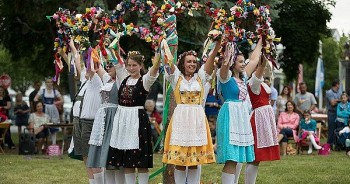 German Calendar with the Public Holidays, Observances And Celebrations German Calendar with the Public Holidays, Observances And Celebrations The 2024–2025–2026 yearly calendar features international events, special days, public holidays, and school vacations for Germany. |
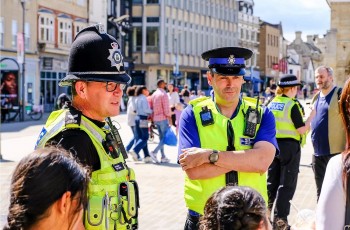 Public Holidays and Leave Policies for Police Officers in the UK Public Holidays and Leave Policies for Police Officers in the UK This article will explore the public holidays observed by law enforcement officers in the UK, the differences in their holiday entitlements compared to other public ... |
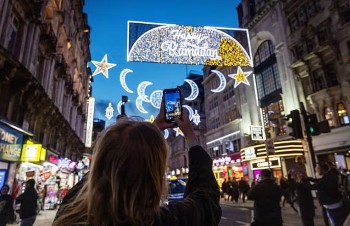 Religious Holidays in the UK in 2025: Dates, Significances, and Celebrations Religious Holidays in the UK in 2025: Dates, Significances, and Celebrations This article will discuss the major UK religious holidays in 2025, including their history, significance, celebration, and status as public holidays or observances. We'll also ... |


























